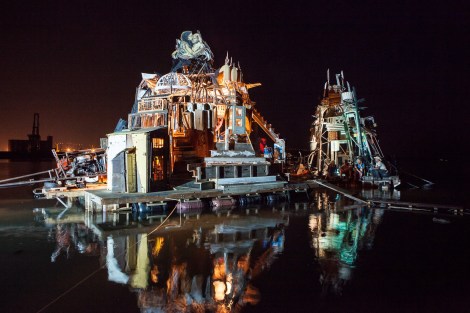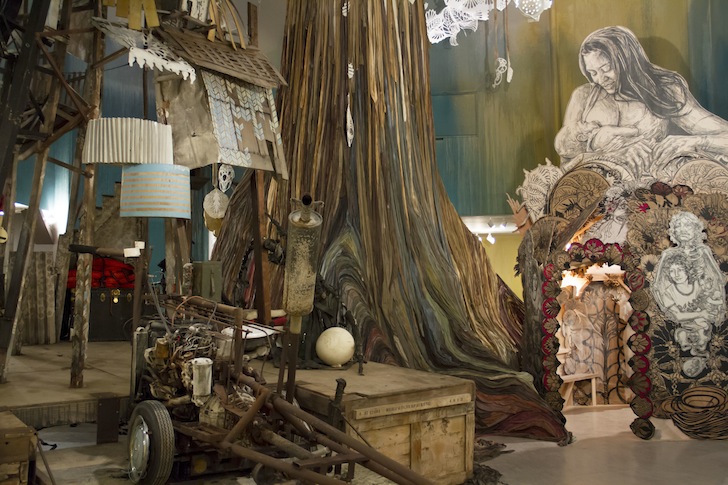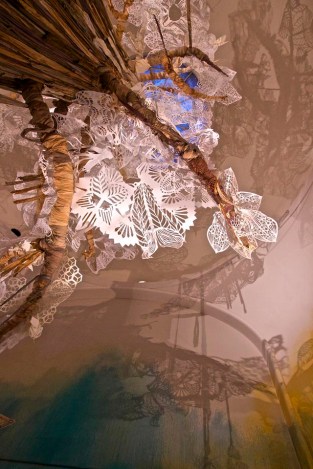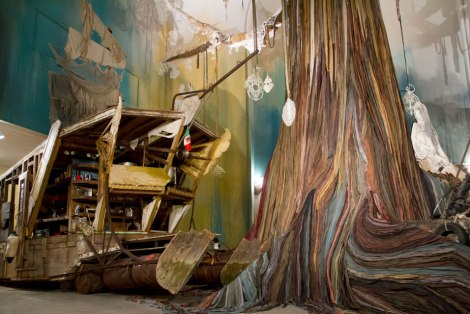Brooklyn street artist Swoon creates art that makes you feel like a kid again. She’s wheat-pasted life-sized portraits on the sides of industrial buildings and transformed an abandoned warehouse into a playground for art and community in post-industrial Braddock, Pa., where she lives and works.
And then there are the rafts, whimsical floating creations that make you want to pull a Peter Pan and hop on board to start your new life as a junk boat sailor. In 2006, Swoon and the adventurous crew of the Miss Rockaway Armada built a raft made entirely from salvaged materials — wood from dumpsters, ropes found on the sidewalk, and a vegetable oil powered engine — and sailed down the Mississippi River from Minneapolis to New Orleans. Since then, she’s made two more boat trips: one with a flotilla of seven rafts and one steam-powered paddleboat down the Hudson River, and another across the Adriatic Sea from Slovenia to Italy for the Venice Biennial with the Swimming Cities of Serenissima.

Tod SeelieClick to embiggen.
This time around Swoon’s given the old rafts new life and brought them indoors to the Brooklyn Museum, for a new exhibit that addresses the loss of people’s homelands because of climate change and rising sea levels. She sat down to talk about the inspiration for the exhibit, and the role of the artist in raising awareness about climate change and other environmental issues.
Q. How did you go from making graffiti art to taking junk rafts out on rivers and seas? And how did these journeys inspire your new exhibit currently up at the Brooklyn Museum?

Bryan WelchSwoon.
A. I started off as a classically trained artist, but then I started working outside on the streets and engaging with cities. Within a couple of years, I realized that I still had this kind of wing of my imagination that was about creating entire spaces and worlds.
So the new exhibit, Submerged Motherlands, is kind of its own world that explores what can happen when people lose their homelands due to rising sea levels. The process of ecological destruction through climate change is just beginning, so I started imagining a fantastical world where bits of cities broke off and developed their own life out at sea and began to navigate their own futures.
The exhibit is centered around this monumental tree sculpture that’s based on a Haitian Mapou tree, which is an enormous sacred tree that used to grow all over Haiti. And then, nested into the base of the tree are these two sculptural rafts that about 30 people lived on and built and navigated down rivers in the summer of 2008-2009. I always wanted the rafts to kind of come back from their water life and just have another life as objects and artifacts.
Q. How did the issues of climate change and rising seas inform your work for Submerged Motherlands?
A. So when I first created these rafts, I was thinking a lot about climate change and about rising seas, and about cities that were built in these very precarious places, and the way that so many communities around the world are really in the most ecologically vulnerable environment.
Six years later, here we are, and Hurricane Sandy has struck and now New Yorkers have this kind of visceral feeling of flood, and devastation, and what happens when you are in these really vulnerable communities in this particular place and time.
So now I’m thinking about the loss of our homeland, which is something we are just starting to experience. There are portraits of people in the exhibit who are in the process of, or who have already lost, their homeland, like a group of indigenous people in Brazil where the government is trying to build this dam along the Amazon River and its tributaries. It’s a billion-dollar project that’s just being shoved through. And the indigenous people have had some success in stalling it, but it’s just such a fucking gigantic machine to go up against.
And then I also work in Braddock, Pa., which is a town that has suffered post-industrial collapse and the loss of jobs and industry. And I just started to think about the link between all of these things. This kind of menacing capitalist process that Braddock suffers from is the other side of the same machine that is displacing populations in Brazil.
Q. What role do you think artists play in raising awareness about climate change and other environmental issues?
A. I think there’s a twofold role. The most basic role is mental and emotional processing. I feel like artists tend to function as a part of the mechanism of mental and emotional processing for a culture. I think the extent of what we’re going through right now with climate change is so large and in such slow motion that I myself find it totally impossible to grasp. It’s too big and too glacial for us to perceive accurately, to really get it. So how do we translate that into a language we can understand so that we can start to create action around it?
The other kind of role that artists can play is by really just plugging into a problem and trying to interact with it concretely. After the earthquake in Haiti I got together there with some people and worked on a rebuilding project. And I learned that small-scale, creative, hands-on solutions are generators for solutions that tackle these problems in a larger way. And so just by using the language of creativity that we as artists are so familiar with, there’s a lot we can do.
Submerged Motherlands will be showing at the Brooklyn Museum in New York until August 24.







